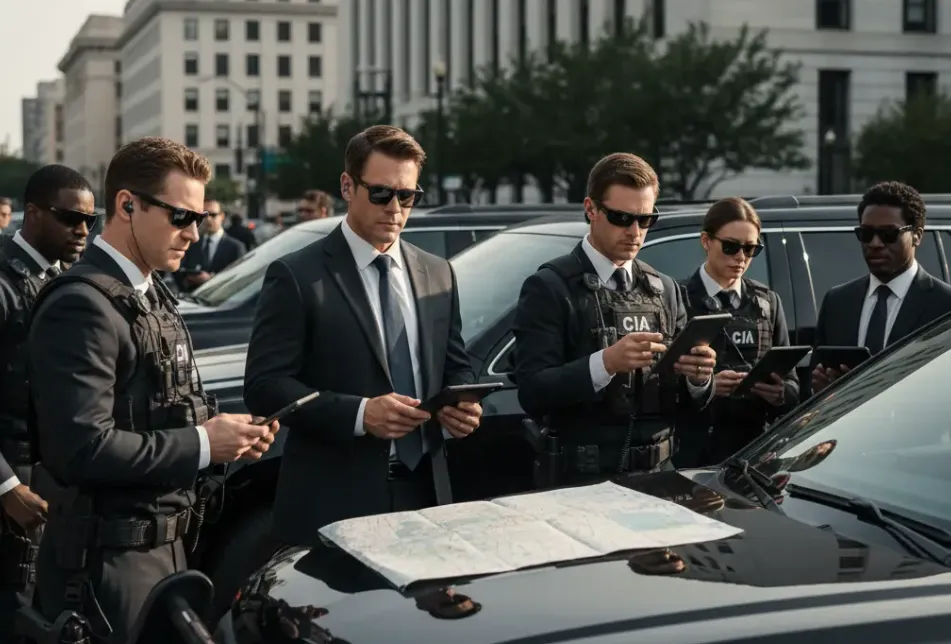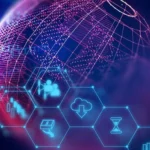In today’s complex world, the threats facing corporate leaders, high-net-worth individuals, and public figures are more dynamic and severe than ever. It’s a reality confirmed by security professionals on the front lines; in a recent global survey, 42% of security chiefs reported a significant increase in threats of violence against company executives. This escalating risk has made professional protection a critical consideration for ensuring personal safety and business continuity.
Yet, for many, the term “executive protection” conjures a stereotypical image: a large, stoic figure in a dark suit and sunglasses, standing guard reactively. This “bodyguard” archetype, focused on physical intervention after a threat has already appeared, is a relic of the past. True, modern executive protection is an entirely different discipline.
This article pulls back the curtain to reveal what a premier executive protection agency really does behind the scenes. It’s not about reacting to danger—it’s about creating an environment where threats are identified, analyzed, and neutralized long before they can ever materialize. It’s about building an invisible shield of safety that allows leaders to remain productive, private, and secure.
Key Takeaways
- True executive protection is proactive, not reactive. Its primary focus is on preventing incidents before they happen through meticulous intelligence gathering and strategic planning.
- The foundation of elite security is “protective intelligence”—a continuous cycle of threat assessment, monitoring, and analysis that informs every protective action.
- A comprehensive security plan integrates multiple services, including advance planning, secure transportation, and close protection, into a seamless ecosystem of safety.
- The quality of an agency is defined by the rigorous training, diverse backgrounds (military, law enforcement), and professionalism of its “seasoned protective agents,” who prioritize discretion and emotional intelligence.
Redefining Security: Beyond the “Bodyguard” Stereotype
The first step in understanding elite protection is to discard the outdated “bodyguard” concept. While the term is popular, it implies a purely reactive, physical presence—a solution for a problem that has already begun. A bodyguard waits for an attack and then responds.
An executive protection agent is a proactive risk management specialist. Their primary job is to prevent threats from ever materializing. They are intelligence analysts, logistics experts, and strategic planners whose work is 99% preparation and 1% execution. The goal is not to win a fight, but to ensure a fight never happens.
This fundamental difference in mindset shapes every aspect of the role.
| Criteria | Traditional Bodyguard | Executive Protection Agent |
| Mindset | Reactive (Responds to threats) | Proactive (Prevents threats) |
| Primary Function | Physical deterrence and intervention | Risk mitigation and intelligence analysis |
| Key Skills | Physical strength, martial arts | Threat assessment, advance planning, surveillance detection, defensive driving, trauma care |
| Environment | Overt, highly visible presence | Discreet, low-profile, and often invisible |
Ultimately, the aim of modern protection is to enable a client’s lifestyle and productivity with minimal disruption. It’s a service designed to be felt in its absence of incidents, not seen in an overt show of force.
The Core of Modern Executive Protection: A Proactive, Intelligence-Led Process
The “invisible shield” isn’t magic; it’s the result of a disciplined, multi-phase process that occurs long before a client ever leaves their home or office. This is where the real work of an elite agency happens.
Phase 1: Protective Intelligence – The Foundation of Safety
Protective intelligence is the bedrock of any legitimate executive protection program. It is a 24/7, continuous process of identifying, assessing, and mitigating potential threats to a client. This isn’t just about spotting immediate dangers; it’s about understanding the entire threat landscape surrounding an individual, their family, and their organization.
This phase involves:
- Threat Monitoring: Systematically monitoring open-source intelligence (OSINT), social media, public records, and deep web sources for direct or indirect mentions of the client that could indicate hostile intent.
- Vulnerability Assessment: Analyzing a client’s routines, public profile, and digital footprint to identify potential weaknesses that could be exploited.
- Investigations: Looking into specific individuals or groups that have demonstrated an unhealthy interest in the client to determine their intent and capability.
The goal is to see and neutralize a threat long before it can gain proximity. The consequences of failing at this stage can be severe.
Phase 2: Advance Planning & Risk Mitigation – Designing the Invisible Shield
With a clear intelligence picture, the next phase is meticulous planning. No movement is made without an exhaustive “advance,” where agents survey and secure every location on an itinerary. This planning makes up the vast majority of an agent’s work.
Key components of this phase include:
- Route Analysis: Planning primary, secondary, and tertiary travel routes, identifying potential choke points, ambush sites, and safe havens along the way.
- Venue Security Sweeps: Physically inspecting hotels, conference centers, restaurants, and offices to identify security vulnerabilities, locate entrances and exits, and establish secure rooms.
- Customized Security Plans: Developing a detailed operational plan for each movement that addresses specific, intelligence-identified risks. This document serves as the blueprint for the entire protective detail.
- Contingency Planning: Creating protocols for a wide range of scenarios, from medical emergencies and natural disasters to vehicle breakdowns or unexpected threats. A proactive plan has an answer for “what if?”
This detailed preparation ensures that by the time the client arrives, the environment has already been assessed, secured, and controlled.
Phase 3: Discreet Execution – Seamless Close Protection
This is the phase most people associate with executive protection, but it’s merely the final, carefully orchestrated execution of the intelligence and planning that came before it. “Close protection” is the physical act of staying with the principal, but its effectiveness depends entirely on the previous phases.
The focus here is on seamless, low-profile security. Agents use subtle techniques to maintain control of the environment:
- Positioning: Using strategic formations to create a protective bubble around the client without being intrusive or obvious.
- Surveillance Detection: Observing the surroundings for signs of hostile surveillance, allowing the team to adjust plans long before a threat can be executed.
- Discreet Communication: Utilizing covert communication systems to coordinate movements and share real-time intelligence among team members.
The work is designed to be nearly invisible, allowing the client to focus on their business and personal life with complete confidence. This is the “invisible shield” in action—a constant presence that is felt through the seamless safety it provides, not through its overt appearance.
The Components of a Holistic Security Plan
World-class protection is an ecosystem of integrated services, not just a single agent following a client. A top-tier agency builds a comprehensive security program tailored to the client’s unique risk profile, lifestyle, and business needs. This holistic plan typically includes several core components working in concert:
- Close Protection: The highly trained agents who provide immediate, personal security, implementing the detailed plan developed behind the scenes.
- Secure Transportation: Armored vehicles operated by expert security drivers trained in evasive maneuvers, defensive driving, and route logistics.
- Residential & Office Security: Hardening the client’s most common environments through technical security countermeasures (TSCM), access control systems, and trained on-site personnel.
- Event Security: Managing safety for public appearances, shareholder meetings, or large private functions, from advance sweeps to crowd control and access management.
This proactive, intelligence-first approach is what separates a standard bodyguard from a true protection specialist. Understanding the full suite of services offered by an executive protection agency VIPs trust is the first step in securing true peace of mind.
The Anatomy of an Elite Protection Agent
Ultimately, the strength of any protective service lies in the quality of its personnel. An elite agency is defined by its agents—their background, skills, and unwavering professionalism. These are not simply physically capable individuals; they are seasoned specialists with a unique blend of hard and soft skills.
- Professional Background: Most elite agents come from distinguished careers in military special forces (e.g., Green Berets, Navy SEALs), federal law enforcement (e.g., Secret Service, Diplomatic Security), or intelligence agencies. This background provides a foundation of discipline, operational experience, and the ability to perform under extreme pressure.
- Essential Hard Skills: Beyond firearms proficiency, agents possess a wide array of technical skills, including advanced defensive and evasive driving, trauma medical training (TCCC), and sophisticated surveillance/counter-surveillance techniques.
- Critical Soft Skills: This is what truly separates the best from the rest. Elite agents exhibit high emotional intelligence, impeccable discretion, superior problem-solving abilities, and calm, clear communication skills. They can blend into a corporate boardroom as easily as they can manage a crisis.
- Rigorous, Continuous Training: The threat landscape is constantly evolving, and so must the agents who counter it. The best agencies invest heavily in continuous training to ensure their team’s skills remain sharp and their tactics are ahead of adversaries.
Conclusion
The world of executive protection has evolved far beyond the reactive bodyguard model. Today, it is a proactive, intelligence-driven discipline where the vast majority of the work happens “behind the scenes.” The safety of a high-profile individual is not secured by muscle, but by meticulous planning, deep intelligence analysis, and the flawless execution of a comprehensive security strategy.
The true measure of success is not a dramatic intervention, but a day, a week, or a year in which nothing happens. This is the purpose of the invisible shield: to create a secure environment that allows leaders to work, travel, and live with confidence and peace of mind. For those they protect, the right security partner is not a cost center, but a vital investment in safety, productivity, and continuity.



